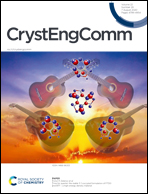Growth of dispersed hydroxyapatite crystals highly intertwined with TEMPO-oxidized cellulose nanofiber†
Abstract
Hydroxyapatite (HAp) provides various attractive functionalities as a biomaterial and facilitates the formation of secondary particles that possess high surface area and durability, such as those used in adsorption columns. An effective approach for their design can be achieved by considering cellulose nanofibers (CNFs) as a template during hybridization to form a framework of secondary particles for HAp. However, the aggregation of HAp was not inhibited by using general CNFs. This study shows that (2,2,6,6-tetramethylpiperidine 1-oxyl) (TEMPO)-oxidized cellulose nanofiber (TOCN) assists in fabricating a dispersed crystalline HAp crystal to form a secondary particle. The growth of HAp in TOCN resulted in the formation of unique secondary particles, comprising dispersed and crystalline forms of HAp and TOCN, wherein they intertwined at an atomic level. This was not observed using other templates, such as bacterial cellulose nanofiber and agar. The chemical properties of TOCN and the gelation of a –COO–Ca2+–COO bridging bond even at diluted conditions, led to an interaction with HAp. The results obtained demonstrated the importance of selecting the proper template for designing a secondary particle composed of HAp crystals and the role of TOCN as a template to hybridize with the material, which possesses a multivalent cation in its composition.



 Please wait while we load your content...
Please wait while we load your content...